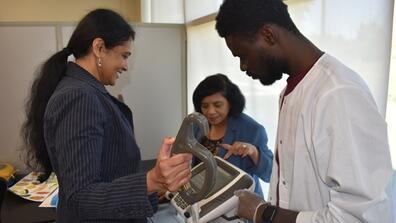
Central State University scientist helps advance citrus greening solution to field trials

A promising new solution to combat citrus greening — a disease responsible for devastating losses in the citrus industry — is advancing to Phase 2 field trials following breakthrough research involving a Central State University scientist.
Pop Test Oncology LLC, operating as Palisades Therapeutics, recently announced that its proprietary compound, TPR1, emerged as the leading candidate among over 200 compounds evaluated by the United States Department of Agriculture. TPR1 will now be tested across citrus groves in replicated field trials designed to evaluate its effectiveness under commercial conditions.

Dr. Anthony Arment, a molecular biologist and professor of biology at Central State University, played a key role in early research and ongoing consultation for the project.
He was asked by Palisades Therapeutics to build on previous studies involving Liberibacter crescens, the closest culturable relative of Candidatus Liberibacter asiaticus, the pathogen behind citrus greening (also known as Huanglongbing or HLB).
“I performed the preliminary work testing the susceptibility of L. crescens to TPR1, as well as other potential compounds,” Dr. Arment said. “The initial research showed that L. crescens was extremely susceptible to antibiotics like TPR1, but we needed a molecule that could withstand light, heat, and the environmental degradation conditions of Florida and stay viable within the trees long enough to be effective.
"Liberibacter spp. grow very slowly, so long-term exposure is critical to control, and TPR1 demonstrated all necessary traits as a potential solution.”
Although citrus is not grown in Ohio and infected tissue cannot be transported, Dr. Arment continues to contribute by consulting on experimental planning and data interpretation. His expertise in molecular biology and microbiology has been crucial in evaluating how the pathogen responds to treatment and ensuring the compound’s safety to citrus trees.
TPR1 works by disrupting the pathogen’s ability to translate genes into proteins, a mechanism that makes it highly effective. The molecule was specifically engineered for agricultural resilience, maintaining stability in harsh environmental conditions.
Field trials will now assess TPR1’s impact on tree health, fruit quality, yield, and its environmental profile. The goal is to halt disease progression and restore productivity to infected trees.
“There are currently no effective treatments for citrus greening,” Dr. Arment noted. “This disease has led to a 75% decline in citrus production over the past 20 years, and the estimate rises to 90% when factoring in hurricanes and real estate development.
"It’s a global issue impacting a $17 billion market.”
Dr. Arment’s involvement in the project also contributes to Central State’s Land-Grant mission. While citrus is not native to Ohio, undergraduate biology students at CSU have participated in research on TPR1 and tested other Palisades products targeting the insect vector responsible for disease transmission.
In addition to the USDA and Central State, Palisades collaborated with the Citrus Research and Development Foundation (CRDF) and Bayer Crop Science. The research collaboration has enabled the rapid evaluation and deployment of innovative solutions to address the devastating impact of HLB on the citrus industry, according to Palisades.
The TPR1 project is led by Dr. Michelle Heck of the USDA, Tom Minter of Palisades Therapeutics, and Dr. Arment of Central State University. Their collective expertise has guided the project from laboratory screening to real-world trials.
As TPR1 moves toward commercial deployment, Palisades Therapeutics is seeking a partner to assist with full EPA/USDA registration and global market rollout. Interested parties can contact Palisades Therapeutics through their website at www.palisadestherapeutics.com.
This advancement marks a hopeful turning point for citrus growers and underscores the value of research collaborations between federal agencies, industry leaders, and academic institutions like Central State University.


